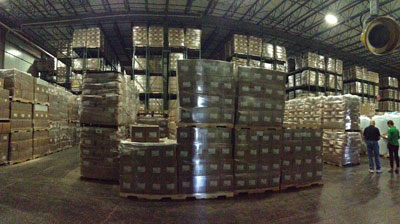Tips for Choosing the Right Warehouse
September 6th, 2014

Have you overlooked the strategic importance that a good warehouse holds? Choosing the correct warehouse is indispensable to catering to your company needs.
Importance of a warehouse
The keys to warehouse selection
Key #1
Strategic Outlook
Key #2
Location Analysis
A thorough analysis of the warehouse location is essential for the following reasons:
Key #3
Room for expansion
This is the major key factor that must be looked in a warehouse because:
Therefore, you must choose a warehouse where future expansion plans can be implemented.
Key #4
System Capability
Key #5
Ease in transportation
Don’t get fascinated with low prices, low transportation access can be the reason for it.
Key #6
Timing of occupancy
Key #7
Warehouse layout
Key #8
Cost
Key #9
Job market connected to the warehouse location

Food grade warehouses require strict standards to ensure health and safety for the consumer of your product. When you are selecting a food grade warehousing partner for your products, it is important to be aware of these standards and what your 3PL is doing to meet and exceed them.
Not all warehouses can be a food grade warehouse. It requires constant monitoring and a specialization that can be difficult to maintain. Diversified Entities is a Merieux Nutrisciences Certified food grade warehouse. Merieux Nutrisciences is the leading internationally accredited provider of food safety, quality and nutrition services with locations in 16 countries. They are dedicated to helping companies worldwide find practical solutions to today’s food safety and quality challenges throughout the supply chain (www.merieuxnutrisciences.com).
A food grade warehouse can be a food storage facility of any size, storing any amount of food for either long or short periods of time. The majority of food grade warehousing facilities adhere to the key requirements for Good Manufacturing Practices, or GMP, as well as Good Hygiene Practices (GHP) and Hazard Analysis Critical Control Point (HAACP). These practices are implemented to ensure a high level of quality assurance.
At every stage of the handling process your food grade storage warehouse must maintain quality assurance and detailed standard operating procedures (SOP). There are four critical Principles for Food Grade Warehouses:
1. Pest Control
2. Master Sanitation Schedule
3. Personal Hygiene and Training Program
4. Lot Traceability
These food grade practices allow for any defects to be reported so that action can be taken to prevent contaminated food products from reaching the consumer.
Diversified Entities, LLC is a Merieux Nutrisciences Certified, Chicago Food Grade warehouse provider, Established in 2003 Diversified Entities, LLC has provided 3PL solutions to local and national companies needing Chicago food grade warehousing and other services.
DE offers over 450,000 square feet of Chicago warehouse space, 75,000 refrigerated, 67 outside dock doors, and 15 rail side doors. DE can provide the proper warehousing inventory management and distribution services required by today’s global organizations. If storage is critical to your organization DE has the warehouse facility and solutions to handle your needs.
For additional information on DE’s warehouse in Chicago go to www.div-ent.com.
Third-party logistics – (abbreviated 3PL) describes businesses that provide one or many of a variety of logistics-related services. Types of services would include public warehousing, contract warehousing, transportation management, distribution management, and freight consolidation. A 3PL provider may take over all receiving, storage, value added, shipping, and transportation responsibilities for a client and conduct them in the 3PL’s warehouse using the 3PL’s equipment and employees, or may manage one or all of these functions in the client’s facility using the client’s equipment, or any combination of the above.
Third party logistics providers typically specialize in integrated operation, Chicago warehousing and transportation services that can be scaled and customized to customers‘ needs based on market conditions and the demands and delivery service requirements for their products and materials.
Hertz and Alfredsson (2003) describe four categories of 3PL providers:
Cross-docking – the practice of receiving product and immediately shipping it out without putting it in a 3PL warehouse – is increasingly valued by companies in fast moving industries, because it allows products to reach destinations faster and more economically. It’s also used by industry leaders, who have recognized the roll cross-docking can play in delivering just-in-time services.
Cross-docking is on the rise, according to the 2011 Cross-Docking Trends Reports. More and more companies are finding added value in the practices ability to lower costs, manage inventory, accommodate customer’s demands, and increase transportation efficiencies.
There are several methods of cross-docking. For instance, products can be received and then immediately loaded outbound without being placed in the 3PL warehouse. They also can be received and staged on the dock, and then be loaded outbound later. Another approach is to receive products, reconfigure the shipment, and then stage on the dock for an outbound later.
By eliminating the put-away process, companies reduce 3PL warehouse requirements and inventory levels. They also consolidate freight to reduce transportation costs and improve product availability. Given that demand is increasingly volatile, it comes as no surprise that cross-docking continues to gain favor. Indeed, companies increasingly implement cross-docking as a means to reduce costs, manage inventory levels, increase efficiencies and accommodate unpredictable customer demand,
Cross-docking has increased significantly in the past three years. The survey completed by The Cross-Docking Trends Reports shows an increase of 16.5% in three years. 68.5% of the companies surveyed are currently cross-docking. Cross-docking is a viable strategy for adapting to current economic times.
The biggest benefits of cross-docking are reducing transportation costs, consolidating shipments, and overall improvement in service. More and more companies are recognizing the value and are looking to outsource the cross-docking service.
There are considerable savings for those doing the cross-docking. Since products aren’t actually put-away, companies reduce on 3PL warehouse labor. Furthermore, by consolidating LTL shipments into full loads, companies are able to improve transportation efficiency and reduce their fuel costs.